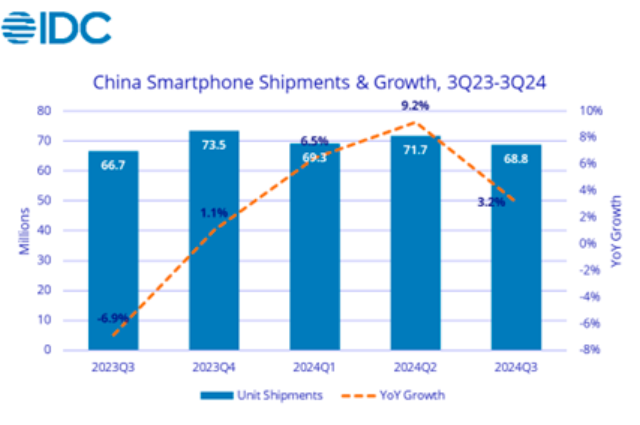China smartphone market share report from IDC indicated Huawei has sold more phones in the country as Apple lost presence in Q3 2024.

Key Insights
China smartphone shipments grew 3.2 percent year over year to 68.8 million units in Q2 2024.
Vivo is the leader in the China smartphone market with 18.6 percent in Q3 2024 vs 15.8 percent in Q3 2023.
This growth suggests that its strategy of distinct product positioning and targeting different market segments (premium and budget) has been effective.
Apple is in the second position with 15.6 percent share vs 16.1 percent.
Huawei has increased its share to 15.3 percent from 11.1 percent.
Xiaomi has market share of 14.8 percent vs 13.6 percent. Honor has market share of 14.6 percent vs 19.4 percent.
Huawei
Huawei’s increased market share in China, reflecting a comeback following years of challenges. Here are the key factors contributing to its success:
Huawei recorded four consecutive quarters of double-digit growth, underlining the company’s strong resurgence in the Chinese smartphone market. This demonstrates sustained consumer interest in Huawei’s offerings.
Huawei’s success can largely be attributed to its innovative product releases, particularly in the foldable phone market. The company launched the world’s first tri-foldable phone, which has attracted significant consumer attention and is expected to play a pivotal role in shaping the future of foldable devices in the market. Huawei’s push for cutting-edge technology has helped the brand distinguish itself from competitors.
Much like other OEMs in China, Huawei has benefited from the wave of pent-up demand that has built up over the past three years. As consumers seek to upgrade their devices, Huawei’s strong portfolio of products has positioned it well to capture a large portion of these buyers.
Huawei, along with other Chinese OEMs like Vivo and Xiaomi, has contributed to the 3.8 percent growth in the Android smartphone market. The brand’s robust performance in the Android ecosystem continues to strengthen its foothold in the domestic market.
Overall, Huawei’s strategic focus on innovation, addressing consumer demand for advanced features like foldables, and capitalizing on the growing momentum in the Chinese smartphone market have all contributed to its impressive market share growth.
Apple
Apple, despite re-entering the top 5 smartphone companies in China with the launch of its iPhone 16 series, has faced challenges that contributed to a decline in market share. Several key factors explain this loss:
Apple’s market share has been impacted by the robust performance of local Chinese manufacturers such as Vivo, Huawei, and Xiaomi. These companies have achieved double-digit growth, largely due to innovative product offerings like foldable phones and budget-friendly devices. Huawei’s resurgence, in particular, with its tri-foldable phone, has attracted significant consumer attention, challenging Apple’s dominance in the high-end segment.
As the Chinese market faces ongoing economic challenges, many consumers are more budget-conscious. While Apple remains a premium brand, Chinese OEMs have been successful in catering to a broader range of consumers, including those looking for more affordable options. This price sensitivity has contributed to Apple’s slower growth in comparison to its competitors, who offer feature-rich smartphones at lower price points.
Apple’s relatively slower pace in adopting new features, such as foldable technology, may have caused some consumers to opt for devices from Chinese brands that are perceived as more innovative in design and technology. The growing popularity of foldables and other new form factors from brands like Huawei and Honor has captured market share in the premium segment, which is traditionally Apple’s stronghold.
While Apple’s iPhone 16 series has performed on par with its predecessor, the premium segment in China appears to be more saturated. This has limited Apple’s ability to capitalize on the wave of device upgrades driven by pent-up demand, as many consumers are turning to alternative premium options from competitors.
In conclusion, while Apple remains a significant player in the Chinese smartphone market, it has faced increasing competition from innovative local brands and economic factors that have eroded its market share, particularly in the high-end segment.
Baburajan Kizhakedath
